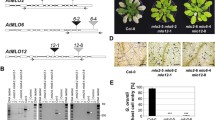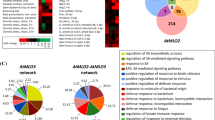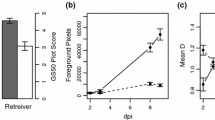Abstract
Recessive mlo resistance alleles of the Mlo locus in barley control a non race-specific resistance response to infection by the obligate biotrophic fungus Erysiphe graminis f.sp. hordei. All the mlo alleles analysed stop fungal growth at the same developmental stage within a subcellularly restricted, highly localized cell wall apposition directly beneath the site of abortive fungal penetration. We report that near-isogenic lines carrying the alleles mlo 1, mlo 3 or mlo 5 undergo dramatic spontaneous formation of cell wall appositions, not only in the absence of the fungal pathogen but also in sterile grown plants. A comparative study of spontaneous and infection-triggered cell wall appositions reveals a high degree of similarity with respect to structure, chemical composition and distinct localization within plant tissue. We show that the rate of spontaneous apposition formation is dependent on the genetic background of the plant and that its onset is under developmental control. Furthermore, spontaneous formation of wall appositions is specifically triggered by mlo alleles, since it is unaffected in the presence of the race-specific resistance allele Mlg. We propose a model for the function of the Mlo locus that suggests that both Mlo and mlo alleles control qualitatively the same apposition-based resistance mechanism, which, in the presence of the wild-type Mlo allele, is merely less efficient to provide protection against the currently common races of E. graminis f.sp. hordei.
Similar content being viewed by others
References
Aist JR (1976) Papillae and related wound plugs of plant cells. Annu Rev Phytopathol 81:107–121
Aist JR, Gold RE, Bayles CJ, Morrison GH, Chandra S, Israel HW (1988) Evidence that molecular components of papillae may be involved in ml-o resistance to barley powdery mildew. Physiol Mol Plant Pathol 33:17–32
Bayles CJ, Ghemawat MS, Aist JR (1990) Inhibition by 2-deoxy-d-glucose of callose formation, papilla deposition, and resistance to powdery mildew in ml-o barley mutant. Physiol Mol Plant Pathol 36:63–72
Christ BJ, Person CO, Pope DD (1987) The genetic determination of variation in pathogenicity. Population of plants pathogens: their dynamics and genetics, Blackwell-Oxford
Ellingboe AH (1972) Genetics and physiology of primary infection by Erysiphe graminis Phytopathology 62:401–406
Eschrich W, Currier HB (1975) Identification of callose by its diachrome and fluorochrome reactions. Stain Technology 39, pp 303–307
Flor HH (1971) Current status of the gene-for-gene concept. Annu Rev Phytopathol 9:275–296
Görg R, Hollricher K, Schulze-Lefert P (1993) Functional analysis and RFLP-mediated mapping of the Mlg resistance locus in barley. Plant Journal (in press)
Hinze K, Thompson RD, Ritter E, Salamini F, Schulze-Lefert P (1991) RFLP-mediated targeting of the mlo resistance locus in barley (Hordeum vulgare). Proc Natl Acad Sci USA 88:3691–3695
Jorgensen JH (1975) Identification of powdery mildew resistant barley mutants and their allelic relationship. In: Caul H (ed) Barley genetics III (Proceedings at the 3rd Barley Genetics Symposium, Garching). Thiemig, Munich, pp 446–455
Jorgensen JH (1977) Location of the mlo locus on barley chromosome 4. In: Induced mutations against plant diseases (Crop Symposium Vienna), pp 533–547
Jorgensen JH (1983) Experience and conclusions from the work at Riso on induced mutations for powdery mildew resistance in barley. In: Induced mutations for disease resistance in crop plants II (International Atomic Energy Agency, Vienna) pp 73–87
Jorgensen JH, Mortensen K (1977) Primary infection by Erysiphe graminis f.sp. hordei of barley mutants with resistance genes in the mlo-o locus. Phytopathology 67:678–685
Kjaer B, Jensen HP, Jensen J, Jorgensen JH (1990) Associations between three mlo powdery mildew resistance genes and agronomic traits in barley. Euphytica 46:185–193
Koga H, Bushnell WR, Zeyen RJ (1990) Specificity of cell type and timing of events associated with papilla formation and the hypersensitive reaction in leaves of Hordeum vulgare attacked by Erysiphe graminis f.sp. hordei. Can J Bot 68:2344–2352
Kolster P, Munk L, Stolen O, Lohde J (1986) Near-isogenic barley lines with genes for resistance to powdery mildew. Crop Sci 26:903–907
Lin M-R, Edwards HH (1974) Primary penetration process in powdery mildew barley related to host cell age, cell type, and occurrence of basic staining material. New Phytol 73:131–137
McKeen WE, Rimmer SR (1973) Initial penetration process in powdery mildew infection of susceptible barley leaves. Phytopathology 63:1049–1053
Ride JP (1975) Lignification in wounded wheat leaves in response to fungi and its possible role in resistance. Physiol Plant Pathol 5:125–134
Schwarzbach E (1976) The pleiotropic effects of the ml-o gene and their implications in breeding. In: Gaul H (ed) Barley genetics III. Thiemig, Munich, pp 440–445
Sherwood RT, Vance CP (1976) Histochemistry of papilla formed in reed carnarygrass leaves in response to noninfecting pathogenic fungi. Phytopathology 66:503–510
Sherwood RT, Vance CP (1982) Initial events in the epidermal layer during penetration. In: Asada Y, Bushnell WR, Quchi S, Vance CP (eds) Plant infection: the physiological and biochemical basis. Japan Scientific Press, Tokyo/Springer, Berlin, pp 27–44
Skou JP (1985) On the enhanced callose deposition in barley with mlo powdery mildew resistance genes. Phytopath Z 112:207–216
Thordal-Christensen H, Smedegaard-Petersen V (1988) Comparison of resistance-inducing abilities of virulent and avirulent races of Erysiphe graminis f.sp. hordei and a race of Erysiphe graminis f.sp. tritici in barley. Plant Pathol 37:20–27
Walbot V, Hoisington DA, Neuffer MG (1983) Disease lesion mimic mutations. In: Kosuge T, Meredith CP, Hollaender A (eds) Genetic engineering of plants. Plenum Press, New York, NY
Wiberg A (1974) Genetical studies of spontaneous sources of resistance to powdery mildew in barley. Hereditas 77:89–148
Wright AJ, Heale JB (1988) Host response to fungal penetration in Erysiphe graminis f.sp. hordei infections in barley. Plant Pathol 37:131–140
Author information
Authors and Affiliations
Additional information
Communicated by H. Saedler
Rights and permissions
About this article
Cite this article
Wolter, M., Hollricher, K., Salamini, F. et al. The mlo resistance alleles to powdery mildew infection in barley trigger a developmentally controlled defence mimic phenotype. Molec. Gen. Genet. 239, 122–128 (1993). https://doi.org/10.1007/BF00281610
Received:
Accepted:
Issue Date:
DOI: https://doi.org/10.1007/BF00281610




